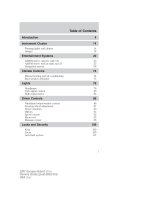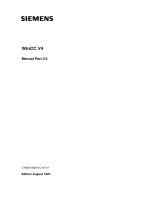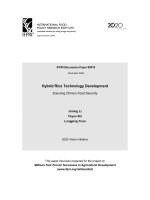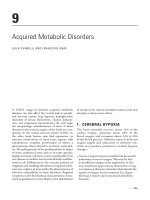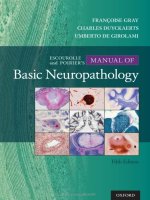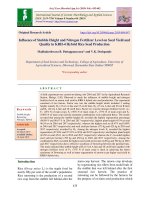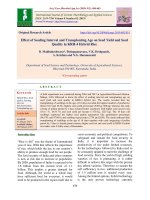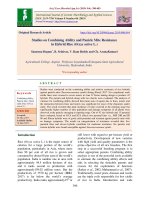Ebook Hybrid rice breeding manual: Part 1
Bạn đang xem bản rút gọn của tài liệu. Xem và tải ngay bản đầy đủ của tài liệu tại đây (7.86 MB, 79 trang )
Hybrid
Rice
Breeding
Manual
HR2-01
1997
International Rice Research Institute
Los Baños, Laguna, Philippines
ISBN 971-22-0103-1
Table of Contents
Foreword,
i
Heterosis breeding and hybrid rice,
Male sterility systems in rice,
1
11
Organization of hybrid rice breeding program
using CMS system, 27
Source nursery,
31
CMS maintenance and evaluation nursery,
Testcross nursery,
45
Restorer purification nursery,
Backcross nursery,
37
49
55
Combining ability nursery,
59
Breeding rice hybrids with TGMS system,
71
Nucleus and breeder seed production of A, B, R,
and TGMS lines, 79
Seed production of experimental rice hybrids,
Evaluation of experimental rice hybrids,
Improvement of parental lines,
85
97
119
Hybrid Rice Breeding Manual
Methods of enhancing the levels of heterosis,
Quality assurance procedures
in hybrid rice breeding, 137
Selected references,
Appendices
Glossary
Hybrid Rice Breeding Manual
149
129
FOREWORD
By 2030 the world must produce 60% more rice than it produced in
1995 to meet demands created by increasing populations and rising incomes.
This production increase must be achieved on less land, with less labor, less
water, and less pesticides, and must be sustainable.
Experience in China,
India, and Vietnam have established that hybrid rice offers an economically
viable option to increase varietal yields beyond the level of semidwarf rice varieties. Several other countries such as Bangladesh, Brazil, Colombia, Egypt,
Democratic People’s Republic of Korea, Japan, Malaysia, Myanmar, Pakistan,
Philippines, Republic of Korea, Sri Lanka, Thailand and USA are currently exploring the prospects of hybrid rice. Availability of adequately trained human
resources is an essential prerequisite for developing an effective national hybrid rice breeding program.
Hybrid rice breeding uses several concepts, skills, and procedures which
are strikingly different from those used for inbreds rice breeding. These must
be learned by plant breeders before initiating a comprehensive hybrid rice breeding program.
The International Rice Research Institute has offered several short-term
training courses in hybrid rice breeding. The experience in these courses indicated that there was a need for a training manual on the subject which describes concepts and illustrates the procedures stepwise.
This manual has
been prepared to serve this need. It is based on the experiences attained at
IRRl and those reported from China and India. The authors have described and
presented hybrid rice breeding procedures stepwise in a systematic manner.
Hybrid Rice Breeding Manual
i
From now on, IRRl will use this manual as a primary courseware for hybrid rice
breeding training courses and recommend its use in national programs interested to develop human resources in hybrid rice breeding.
I compliment the authors and all others involved in developing this extremely useful training ware.
G. H. Rothschild
Director General
ii
Hybrid Rice Breeding Manual
AKNOWLEDGMENT
Adviser
: Robert T. Raab
Editor
: Madeline B. Quiamco
Supervisor
: Gina E. Zarsadias
Layout
and graphic design
: Marie A. Clabita
Secretarial
assistance
: Leni B. Nazarea
Heterosis breeding, which exploits the phenomenon of hybrid vigor,
has proven to be a practical method of crop improvement, especially
for increasing yield potential in many crops. This phenomenon has
been exploited primarily in several cross and often cross-pollinated
crops such as maize, pearl millet, onion, sorghum, cotton, etc. but its
application is also being extended to several self-pollinated crops
including rice. Rice is the staple food providing about 35-59% of the
total calorie intake of people in South and Southeast Asia. The demand for rice would be 800 million t by 2020. This means that we
have to produce about 350 million t more rice by 2020 than what we
are producing today to feed the ever increasing population. Among
the diferent approaches contemplated to meet this challenge, hybrid
rice technology has already shown potential. In the past, adoption of
hybrid technology in rice was considered impractical because of the
strict self-pollinating nature of the crop and skepticism about the practical feasibility of producing hybrid seed on a commercial scale.
Fortunately, rice breeders have overcome these hurdles by developing
a usable system of cytoplasmic-genetic male sterility and packages
for efficient and economic seed production. More than 50% of the
total rice area in China is planted to hybrid rice, and many countries
outside China are developing and exploiting hybrid rice technology.
Heterosis breeding
What is heterosis?
The term heterosis, often used synonymously with hybrid vigor, refers to
the superiority of the F1 hybrid over its parents.
Hybrid Rice Breeding Manual
1
•
Expression of heterosis is confined to the first generation only. Thus,
farmers have to buy fresh seeds every season to raise a commercial
crop.
•
Heterosis may be positive or negative. Both positive and negative heterosis are useful in crop improvement, depending on the breeding objectives. For example, positive heterosis is desired for yield, but we look
for negative heterosis for traits like days to maturity and height.
Types of heterosis
Heterosis is expressed in three ways, depending on the reference which
is used to compare the performance of a hybrid (Fig. 1.1).
•
Mid-parent heterosis -- The increase or decrease in the performance
of the hybrid in comparison with the mid-parental value.
•
Heterobeltiosis -- The increase or decrease in the performance level
of the hybrid in comparison with the better parent of the cross combination.
•
Standard heterosis -- The increase or decrease in the performance of
a hybrid in comparison with the standard check variety of the region.
From the practical point of view, standard heterosis is most important
because we are trying to develop hybrids which are better than the existing high yielding varieties grown commercially by farmers.
2
Hybrid Rice Breeding Manual
Fig. 1.1 Different types of heterosis.
Hybrid Rice Breeding Manual
3
How is heterosis measured?
Measurement of heterosis is quite simple. It is generally expressed as
percent increase or decrease in the performance of a hybrid in comparison with
the reference variety or a parameter.
Mid-parent
heterosis (%)
=
F1 - Mid parent
Mid parent
Heterobeltiosis (%)
=
F1 - Better parent
Better parent
x 100
Standard
heterosis (%)
=
F1 - Check variety
Check variety
x 100
x 100
Genetic basis of heterosis
Two major hypotheses have been proposed to explain the genetic basis
of heterosis: dominance hypothesis (Davenport, 1908), and overdominance
hypothesis (East, 1908 and 1936).
•
Dominance hypothesis
-
4
states that heterosis is due to the accumulation of favorable dominant genes in a hybrid derived from the two parents (Fig. 1.2).
Hybrid Rice Breeding Manual
Fig. 1.4 Illustration of dominance hypothesis to explain genetic basis for
heterosis.
This was demonstrated in a pea hybrid whose parents had different dominant
genes for node number and internodal length. The hybrid was much taller than
either parents. The increased height was due to the accumulation of both
dominant genes in a hybrid.
•
Overdominance hypothesis
-
states that heterozygotes (Aa) are more vigorous and productive
than either homozygotes (AA or aa). This has been proven in traits
controlled by single or few genes. Heterozygotes perform a given
function, over a range of environments, more efficiently than either homozygotes (East, 1936).
Studies on genetic basis of heterosis for polygenic traits in various crops
have shown that heterosis is the result of partial to complete dominance, overdominance, and epistasis, and may be a combination of all
these (Comstock and Robinson, 1952).
Hybrid Rice Breeding Manual
5
Evidence of real overdominance for quantitative traits is hard to find.
However, apparent overdominance due to non-allelic interaction and
linkage disequilibrium is a common contributor to heterosis (Jinks, 1983).
Heterosis may also be due to the specific positive effects of the cytoplasm of the maternal parent on the nuclear component of the paternal
parent. Differential heterosis observed between the same pollen parent
and CMS lines of different cytosterility sources is an example of this kind
of heterosis.
It is indeed difficult to explain the genetic basis of heterosis for a complex trait like yield because of the complexity of its inheritance. Hybrid
crop breeders believe that no single hypothesis can explain the basis of
heterosis; perhaps all the above stated hypotheses may work jointly to
explain this phenomenon. Lack of clear understanding of the genetic
basis of heterosis has not prevented plant breeders from exploiting this
phenomenon to raise crop yields.
6
Hybrid Rice Breeding Manual
Hybrid rice
What is hybrid rice?
Hybrid rice is the commercial rice crop grown from F1 seeds of a cross
between two genetically dissimilar parents.
•
Good rice hybrids have the potential of yielding 15-20% more than the
best inbred variety grown under similar conditions.
•
To exploit the benefits of hybrid rice, farmers have to buy fresh seeds
every cropping season.
Why hybrid rice?
We need to go for hybrid rice because
•
yield levels of semi-dwarf varieties of the green revolution era have plateaued.
•
more and more rice has to be produced on less land and with less
inputs.
•
demand for rice is rapidly increasing with the increase in population,
especially in less developed countries (Fig. 1.3).
•
hybrid rice varieties have shown 15-20% higher yield potential than
inbred rice varieties under farmers’ field conditions.
•
hybrids have shown their ability to perform better under adverse conditions of drought and salinity.
Hybrid Rice Breeding Manual
7
Fig 1.3 Projection of population growth and demand for rice, 1990-2025.
8
Hybrid Rice Breeding Manual
How is hybrid rice developed?
Rice is a strictly self-pollinated crop. Therefore, for developing commercial rice hybrids, use of a male sterility system is essential. Male sterility by
genetic or non-genetic means makes the pollen unviable and such rice spikelets are incapable of setting seeds through selfing. Thus, a male sterile line can
be used as female parent of a hybrid.
A male sterile line, when grown side by side with a pollen parent in an
isolated plot, can produce a bulk quantity of hybrid seed due to cross pollination with the adjoining fertile pollen parent.
The seed set on male sterile plants is the hybrid seed which is used for
growing the commercial hybrid crop.
Hybrid Rice Breeding Manual
9
10
Hybrid Rice Breeding Manual
The use of a male sterility system is a prerequisite for commercial
exploitation of heterosis in rice. Though several male sterility systems are known to occur in rice, cytoplasmic-genetic male sterility
has been widely used for developing rice hybrids. Recent discovery of
a genetic male sterility mechanism influenced by environmental factors is getting serious attention from hybrid rice breeders. To a limited extent, chemical gametocides have also been used to induce male
sterility in rice.
Male sterility systems
The following genetic and non-genetic male sterilily systems are known
for developing rice hybrids:
-
Cytoplasmic-genetic male sterility
-
Environment-sensitive genetic male sterility
-
Chemically-induced male sterility
Cytoplasmic-genetic male sterility
It is caused by an interaction between genetic factor(s) present in cytoplasm and the nucleus. Absence of a sterility inducing factor either in the
cytoplasm or in the nucleus makes a line male fertile (Fig. 2.1).
Presence of certain dominant restorer gene(s) in the nucleus makes a
line capable of restoring fertility in the hybrid derived from it and a CMS line
(Fig. 2.1).
Hybrid Rice Breeding Manual
11
Fig. 2.1
12
Schematic description of cytoplasmic genetic male sterility system.
Hybrid Ries Breeding Manual
•
The cytoplasmic-genetic male sterility system involves
1.
a CMS (A) line
2.
a maintainer (B) line
3.
a restorer (R) line
A CMS line is multiplied always by crossing it with its maintainer line,
either by hand-crossing (to produce small quantities of seed) or by outcrossing in an isolated plot (to produce bulk quantities of seed). Since
the CMS line is always maintained by crossing it with its maintainer line,
the two lines (A and B) are similar morphologically except that ‘A’ line is
male sterile and ‘B’ line is male fertile. Occasionally, the two lines may
show differences in some morphological and agronomical traits which
are influenced by the cytoplasmic factors inducing male sterility. Restorer or R line possesses dominant fertility-restoring genes. When
crossed with the CMS line, it restores fertility in the derived F1 hybrid.
Since this sytem involves the use of three lines (A, B, and R lines), the
hybrids developed by using this male sterilily system are known as threeline hybrids.
Procedures for identifying a CMS source
CMS sources can be identified in
-
inter-varietal reciprocal crosses
-
inter-specific crosses
Hybrid Rice Breeding Manual
13
Identifying CMS sources in inter-varietal crosses
Differences in reciprocal crosses between varieties with respect to
male sterility is attributed to the cytoplasmic-genetic interaction (Fig.
2.2).
Example: Chinsurah Boro-ll source
Fig. 2.4 Identification of new CMS soutres in inter-varietal crosses.
14
Hybrid Rice Breeding Manual
The occurrence of high frequency of completely male sterile plants
in BC2, generation indicates that variety B is a donor of cytoplasmic
factor-inducing male steriliiy and variety A is a maintainer. Several rice
varieties, viz., Chinsurah Boro II, Taichung Native 1, ARC 13829 etc.,
possess male sterility-inducing factors in their cytoplasm.
Identifying CMS sources in inter-specific crosses
Crossing between wild species and cultivated varieties can also
help to identify new CMS sources (Fig.2.3).
Fig. 2.3 Identification of new CMS sources in inter-specific crosses.
Hybrid Rice Breeding Manual
15
Some sources of male sterility inducing cytoplasm in rice.
•
Need for diversified CMS sources.
Most of the rice hybrids cultivated in China and elsewhere are
based on the WA system of cytosterilily. Such overdependance an a
single cytosterility source may be disastrous in case there is a sudden
outbreak of pests and diseases, and if susceptibility is associated with a
CMS-inducing factor. Therefore, diversification of CMS sources should
be an important component of a strong hybrid rice breeding program.
16
Hybrid Rice Breeding Manual
